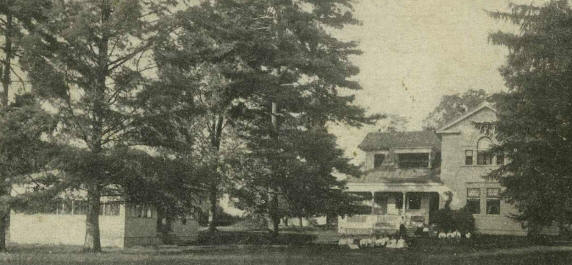“Beechmore”
Great-Aunt Sally Tyler’s Home in “The Little Colonel”
Real Life Home of Captain Thomas Floyd and Blanch Weissinger Smith,
Hattie Cochran’s (The Little Colonel’s) Great Aunt and Uncle
Beechmore: The Jennie Casseday Rest Cottage Years
Beechmore as it looked during the time it served as Jennie Casseday’s Rest Cottage for Working Women. Originally built around 1830 by Michael and Catherine Souther, it was next owned by Catherin’s brother, Joseph Clore, and then by novelist and poet Catherine Anne Warfieldbefore it was purchased by Captain Thomas Floyd Smith. After Smith’s death, it became the Rest Cottage for Working Women until the 1940s, when it was sold to Mrs. Mary Crain for a nursing home. Following her death, the house quickly went to ruin and was eventually torn down. The 64-acre property is now the site of The Woods of Pewee Valley subdivision.
Beechmore appears in the very first book of the “Little Colonel” series. Though Annie Fellows Johnston never refers to the house by name, it is the fictional Lloydsboro Valley home of the Tyler family – the Little Colonel’s great-aunt and -uncle.
The Tylers are first mentioned in Chapter II of “The Little Colonel,” published in 1895:
“Yo’ great-aunt Sally Tylah is comin’ this mawnin’,” said Mom Beck, the day after their visit to the hotel. “Do fo’ goodness’ sake keep yo’self clean. I’se got too many spring chickens to dress to think ’bout dressin’ you up again.”
“Did I evah see her befo’?” questioned the Little Colonel.
“Why, yes, the day we moved heah. Don’t you know she came and stayed so long, and the rockah broke off the little white rockin’-chair when she sat down in it?”
“Oh, now I know!” laughed the child. “She’s the big fat one with the curls hangin’ round her yeahs like shavin’s. I don’t like her, Mom Beck. She keeps a-kissin’ me all the time, an’ a-‘queezin’ me, an’ tellin’ me to sit on her lap an’ be a little lady. Mom Beck, I de’pise to be a little lady.”
In Chapter III, we learn that Sally Tyler is the Old Colonel’s wife’s half-sister:
“My great-aunt Sally Tylah is to ou’ house this mawnin’,” she announced, confidentially. “That’s why we came off. Do you know my Aunt Sally Tylah?”
“Well, slightly!” chuckled the Colonel. “She was my wife’s half-sister. So you don’t like her eh? Well, I don’t like her either.”
And in Chapter IX, we learn that the Tyler home is located in Lloydsboro Valley, when Papa Jack decides to take an ill-advised walk to the Post Office to mail a letter while still recuperating from the long illness he contracted in the West:
“The clouds have all blown away and left us their silver linings,” said Mrs. Sherman the day her husband was able to go out-of-doors for the first time. He walked down to the post-office, and brought back a letter from the West. It had such encouraging reports of his business that he was impatient to get back to it. He wrote a reply early in the afternoon, and insisted on going to mail it himself.
“I’ll never get my strength back,” he protested, “unless I have more exercise.” It was a cold, gray November day. A few flakes of snow were falling when he started.
“I’ll stop and rest at the Tylers’,” he called back, “so don’t be uneasy if I’m out some time.”
Just as in the story, Beechmore was the home of real-life Little Colonel Hattie Cochran’s great-uncle and -aunt, Captain Thomas Floyd Smith and his wife Blanch Weissinger Smith. Though Annie Fellows Johnston portrays “Great Aunt Sally Tyler” as the half-sister of the Old Colonel’s late wife, in reality, Blanch and Colonel George Washington Weissinger were full sister and brother, according to the Weissinger family genealogy below:
- GEORGE WASHINGTON WEISSINGER (1807-1850) married AMANTHUS BULLITT in May, 1829 and had four children:
- BLANCH, (1830/1832- 1887) Married January 21, 1858 to CAPTAIN THOMAS FLOYD SMITH, son of Major Thomas Floyd Smith and Emilie CHOUTEAU.
- SALLIE (1834-1856). Married to HERMAN BECKURTS
- GEORGE WASHINGTON, JR. COL. (Dec. 11, 1836-February 24, 1903) Married December 5, 1865 to AMELIA NEVILLE PEARCE, daughter of Edmund Pearce and Myra Steele.
- HARRY (November 24, 1842 – May 9, 1915) Married June 27, 1867 to ISABELLA MUIR, daughter of Judge Peter Brown Muir and Sophronia.
Volume IV of “History of Kentucky,” by William Elsey Connelly and E.M. Coulter, Ph.D., published by the American Historical Society in 1922, provides the following profile of Captain Thomas Floyd Smith on page 83:
Captain Thomas Floyd Smith was born in Missouri in 1835, was reared in that state and in Kentucky, and was commissioned a first lieutenant in the United States Army by Jefferson Davis, then secretary of the war. At the outbreak of the war-between-the-states he was commissioned a captain in the Confederate army. He was one of the organizers of the Washington Guards, a famous military company of St. Louis, Missouri. After the war Captain Smith located in Oldham County, Kentucky, where he devoted the rest of his years to farming and planting. He was a lover of fine horses and had some noted stock on his place. He was also an ardent sportsman and found his recreation in hunting big game. He was a Democrat, and a member of the Masonic fraternity. Captain Smith died in 1890. His wife, Blanch Weissinger, was born in Jefferson County, Kentucky, in 1848 and died in 1897. (NOTE: Blanch Weissinger’s birth date provided in this profile must be wrong, since she would only have been ten years old when she married Thomas Floyd Smith.) Of their six children, two died in infancy and the four still living are: Amanthis Bullitt Smith; George Weissinger Smith, present mayor of Louisville; Anna, wife of Frank C. Carpenter; and Thomas Floyd, youngest of the family.
A simple obituary ran in the Louisville “Courier-Journal” when he died:
Capt. Smith’s Funeral
The funeral of the late Capt. Thomas Floyd Smith took place at 1:30 o’clock yesterday afternoon. Brief services were held at his late residence in Pewee Valley, after which the remains were brought into Cave Hill Cemetery.
According to “The United Presbyterian Church in Pewee Valley 1866-1966 100th Anniversary” booklet, Blanch Weissinger Smith at one time served as president of the Pewee Valley Presbyterian Church’s women’s group, so the Smiths were presumably members there and were acquainted with other members, such as the Craigs of Edgewood, the Muirs of Oaklea, Rev. T.H. Cleland’s family and the Matthews of Clovercroft who also served as models for many of the characters in the Little Colonel stories.
Captain Thomas Floyd Smith and Blanch Weissinger Smith are buried in Cave Hill Cemetery, Section A, Lot 144, Part SW1/3, Graves 3 and 4.
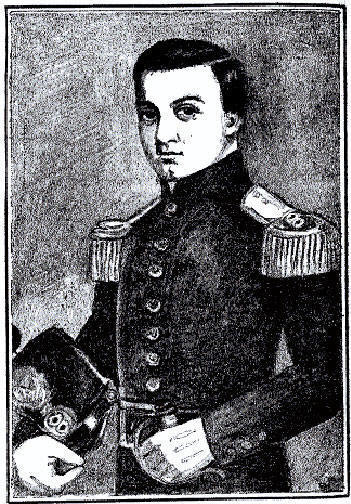
Portrait of Captain Thomas Floyd Smith
(1835-1890)
Captain Smith’s great-granddaughter, Olivia Smith, says that according to family legend, the portrait above was in the “Little Colonel” stories. We believe it may have served as Annie Fellows Johnston’s inspiration for the portrait of the Old Colonel’s dead son, Tom, described in Chapter IX of “The Little Colonel:”
EVERY evening after that during Lloyd’s visit the fire burned on the hearth of the long drawing-room. All the wax candles were lighted, and the vases were kept full of flowers, fresh from the conservatory.
She loved to steal into the room before her grandfather came down, and carry on imaginary conversations with the old portraits.
Tom’s handsome, boyish face had the greatest attraction to her. His eyes looked down so smilingly into hers that she felt he surely understood every word she said to him.
Tom’s picture is mentioned again in Chapter V of the “Little Colonel’s House Party,” when the Little Colonel introduces Betty to all the old family portraits at The Locust:
“That’s my grandmothah, Amanthis,” said Lloyd’ pausing in her song, “and that’s the way she looked the first time grandfathah evah saw her. And heah’s Uncle Tom in his soldier clothes, and this is mothah’s great-great-aunt that was such a belle in the days of Clay and Webstah.”
Olivia Smith is in possession of the portrait, as well as Captain Smith’s epaulets. Unfortunately, his home, Beechmore, is no longer standing. According to documents available at The Filson Historical Society in Louisville, Ky., it was sold after Captain Smith’s death and turned into Jenny Casseday’s Rest Cottage for Working Women in 1896, a summer vacation place for working women with limited financial resources. Beechmore was located at the end of what is now Rest Cottage Lane.
Census information provided by Toni Langlais shows that for a time in the 1880s, Hattie Cochran’s mother, Amelia Weissinger Cochran (Annie Fellows Johnston’s model for Mrs. Sherman in the series) lived in Beechmore with her aunt, uncle and cousins after her mother died:
1880 census Rollington District Oldham County, Kentucky
- Smith, Thomas, age 45
- Blanche, wife, 41
- Amanthus, daughter, 19
- George, son, 15
- Anna, daughter, 13
- Thomas, son, 11
- Weissinger, Amelia, niece, 12
Not surprisingly, both Amelia and her daughter, Hattie, remained close to their cousins throughout their lives. According to“Louisville’s First Families -A SERIES OF GENEALOGICAL SKETCHES” written by Kathleen Jennings and published by the Standard Printing Co. in 1920, those cousins included: “Mayor George Weissinger Smith, who married Nell Hunt, a descendant of the Prathers, another pioneer family; Mrs. Amanthis Jungbluth, Thomas Floyd Smith, who married Mary Bruce, and Nan Pope Smith, who married Frank Carpenter.” We have been able to gather detailed information on three of the four cousins
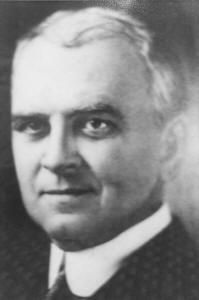 .
.
George Weissinger Smith, Mayor of Louisville 1917-1921
From Metro Louisville Archives
Profile of George Weissinger Smith (October 10, 1864 – 1931)
(from Wikipedia)
George Weissinger Smith was mayor of Louisville from 1917 to 1921. His maternal grandfather, George Weissinger, published the “Louisville Journal” (which became the “Courier-Journal”) during the controversial tenure of George D. Prentice.
George Smith graduated from Louisville Male High School n 1883, from the University of Virginia in 1886, and from the University of Louisville School of Law in 1887. He practiced law throughout the rest of his life. He entered politics in 1898 with his election to the Kentucky General Assembly.
Smith ran for mayor in 1917 on an anti-corruption platform. Louisville’s dominant political boss for three decades, John Henry Whallen, had died in 1913 and his less charismatic brother was unable to use the party’s political machine to defeat Smith. Smith followed through on election promises, shutting down brothels and gambling along the then-seedy Green Street. After the “Louisville Herald” drummed up public interest with a naming contest, the Republican-majority city council gave the street its modern name, Liberty Street, in 1918. He also ordered the Louisville Police Department to assist federal agents in enforcing Prohibition.
The administration soon focused on the World War I effort, with Smith himself involved in war bond drives. Camp Zachary Taylor, one of the largest training camps built for the war effort, was located at what was then the edge of the city.
The city grew 40 percent in size during his administration through annexation of surrounding areas. After his term as mayor, he served as president of the Louisville Water Company until 1926.
He lived on Cherokee Road with his family, and died in 1931 of a cerebral hemorrhage. He was buried in Cave Hill Cemetery.
According to the 1910 census, he was living at 1870 Fourth Street in Louisville. By 1920, he was living at 2007 S. Second Street. His profile in “Who’s Who Louisville,” 1926 lists him at 3018 Grinstead Drive:
SMITH, George Weissinger, ex-mayor; b. Lou., Ky., October 10, 1864; s. (Capt.) Thomas F. (U.S.A) and Blanche (Weissinger) Smith; ed. Student U. of Va., 1883-1886; L.L.B, U of L, 1887; Began practice of law in 1887. Mem. Ky. House of Rep, 1801; Mayor of Lou., 1917-1921. Now pres. Lou. Water Co, m. Ellen Hunt of Lou., Ky., Oct. 30, 1890. Republican. Presbyterian. Formerly pres. Parental Home and School Com. of Jefferson co.; formerly trustee Lou. School of Reform. Served as private with Co. F., Lou. Legion, for three years. Mem. Lou. Bar assn., Pi Kappa Alpha. Clubs: Lawyers’, Audubon Country. Home: 3018 Grinstead Dr. Office: 435 S. Third.
George Weissinger Smith and Nell Hunt Smith (died 1952) are buried in Cave Hill Cemetery, Section Q, Lot 77.
They had four children:
- Blanche Weissinger Smith, named after her paternal grandmother;
- Hunt C., presumably named for his mother’s side of the family;
- Karl J., (August 28, 1805- 1986) possibly named for his uncle, Karl Jungbluth, married to George’s sister, Amanthis; and Rozel Weissinger, named for his paternal grandmother’s half-brother who died in 1896.
Blanche and her cousin, Hattie Cochran, made their debuts the same year, according to “Sunshine and Shadow,” the memoir of Cary Hoge Mead, privately published in 1983, pgs. 68-69:
. ..They (the debutantes) were a delightful group that year, and they all had a glorious time; Eliza Grinstead, whom William (Cary’s brother) described as having a flower-like face and stem-like figure — Julia Kinkead, who was a redhead and full of fun — Lala Swearingen, also a redhead — Nellie Ganter, a darling — Hattie Cochran (the Little Colonel) and her cousin, Blanche Weissinger Smith, with whom Peyton (Cary’s brother) fell completely and permanently in love — to name a few whom I knew and loved the most.
On April 17, 1913, Blanche and Peyton Hoge married. Their son, Peyton Hoge, III, later became Mayor of Anchorage. Annie Fellows Johnston undoubtedly knew the young couple well, because they lived for a time in The Gables — “a dear little house they rented from Mrs. Johnston,” Mead observed in her memoirs. By the 1920 census, they were living with Blanche’s father, George, at 2007 S. Second Street and Peyton Hoge, Jr. was working as an insurance agent.
Their daughter, Blanche Weissinger Smith Hoge (died 1980) and her husband, Peyton Harrison Hoge, Jr. (died 1977), are buried with Blanche’s grandparents in Section A, Lot 144, Part SW1/3, graves 1 and 2.
The 1920 census shows that George’s son, Hunt C. Smith, was married to Mildred Lee (Bolling) Smith, living with his in-laws, Alfred and Sammie Bolling at 2015 S. Second Street, and working for his uncle, Thomas Floyd Smith, III, at Louisville Paper Company. The 1930 census lists him as a lawyer living at 2524 Glenmary Avenue. He is buried in Cave Hill Cemetery on March 25, 1972, Lot M, Section 117, grave 12.
George’s son, Karl Smith, also worked for his uncle, Thomas Floyd Smith, III, as the advertising manager for Louisville Paper Company, according to “Who’s Who in Louisville,” 1926. He was married to Rebbie Smith and lived at 1768 Sulgrave Road:
SMITH, Karl, advertising man.; b. Lou, Ky, Aug. 28, 1805; s. George Weissinger and Ellen Carpenter (Hunt) Smith; ed. Grade school, L.M.H.S. Advertising mgr. Lou. Paper Co. m. Bobbie Stuart Smith of Atlanta, Ga. Oct. 5, 1920. Presbyterian. 2nd lt. of Inftry. During World War. Club: Advertising. Home: 1768 Sulgrave Rd. Office: Lou. Paper Co.
Karl was also involved in developing The Little Colonel Game put out by the Selchow & Righter Co. in New York, according to the game’s explanation printed on the inside cover of the box:
…The game board, depicting Lloydsborough Valley, its homes, churches and other points of interest, was drawn by Mr. Karl Smith, who is a first cousin of the original “Little Colonel”, Hattie Cochran, now Mrs. Albert Dick of Louisville, Ky…
He died August 7, 1986. His wife, Rebbie, died on January 1, 1980. They are buried in Cave Hill Cemetery, Section Q, Lot 77, graves 9 and 8.
Rozel Weissinger Smith, too, worked for his uncle as a salesman, according to the 1920 census. He died August 10, 1983 and is buried at Cave Hill Cemetery, Section Q, Lot 77, grave 12.
Profile of Thomas Floyd Smith (August 31, 1868-May 16, 1958)
(from “History of Kentucky,” Volume IV, by William Elsey Connelly and E.M. Coulter, Ph.D., published by the American Historical Society, 1922, pgs. 83-84:)
THOMAS FLOYD SMITH, whose entire mature career has been devoted to the paper business, wholesale and manufacturing, is president of the Louisville Paper Company, and a man justly prominent in civic and business affairs.
He was born in Jefferson County, Kentucky, August 31, 1869, a son of Captain Thomas Floyd and Blanche (Weissinger) Smith. His great-grandfather, Colonel Thomas Floyd Smith, married Emelie Chouteau daughter of August Chouteau, who was one of the conspicuous pioneer citizens of St. Louis, Missouri. The Chouteau home was one of the first established in that city. The grandfather of the Louisville business man was also Colonel Thomas Floyd Smith, who married a relative of Colonel John Floyd, one of the historic characters of early Kentucky. Grandfather Smith was an intimate friend of Jefferson Davis and Zachary Taylor…
…Thomas Floyd Smith was educated in the schools of Oldham and Jefferson counties, and the first money he ever earned was picking grapes at fifty cents per day. He became connected with a wholesale paper concern at Louisville at the age of nineteen, and subsequently was one of the organizers of the Louisville Paper Company, of which he has been president and acting head for many years. This is one of the largest wholesale paper concerns in the South, and has branch offices in many southern cities. Mr. Smith served two terms as president of the Central State Paper Dealers Association, and also is a past president of the National Paper Trade Association, which includes in its membership all the large paper manufacturers of the United States.
For many years, Mr. Smith has been associated with Louisville’s business and civic affairs. He served three terms as president of the Louisville Board of Trade. He was one of the organizers and vice president of the Louisville Industrial Foundation. He was one of the commission appointed by the mayor to raise a million dollars for the building of a Memorial Auditorium, and had an active charge of the financial campaign. He is a trustee of two schools in Jefferson County, the Rogers Clark Ballard School, and the Jacobs (Colored) School. Mr. Smith is a republican voter, and a member of the Presbyterian Church.
On April 26, 1898, he married Mary Bruce, a native of Louisville, and daughter of Horatio W. and Elizabeth (Helm) Bruce. Her mother was a daughter of Governor John Helm of Kentucky, and a granddaughter of Benjamin Hardin, the eminent Kentucky lawyer. Judge H.W. Bruce was chief attorney for the Louisville and Nashville Railway at the time of his death. He was elected by the Provision Legislature of Kentucky to a seat in the Confederate Congress. Mr. and Mrs. Smith have two children: Bruce, a student at Yale University, and Thomas Floyd (NOTE: Olivia Smith’s father), the fourth of the name in as many successive generations.
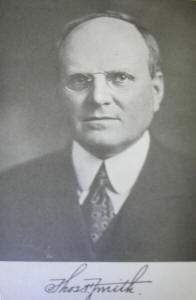
Louisville Paper Company Founder Thomas Floyd Smith, IV
from Volume IV of “History of Kentucky,”
by William Elsey Connelly and E.M. Coulter, Ph.D., American Historical Society, 1922
The Smiths were also members of Pewee Valley Presbyterian Church, and like her mother-in-law before her, Mary Bruce Smith served as president of the women’s group.
In her autobiography, “The Land of the Little Colonel,” Annie Fellows Johnston mentions that her stepson John worked for the Louisville Paper Company, after his graduation from the military academy in Highland Park. Most likely, the Johnston family’s acquaintance with Thomas Floyd Smith, III helped him land the job.
By 1920, census information shows that Thomas Floyd Smith, III had left Pewee Valley and moved to 102 River Road in Glenview, Kentucky. The 1926 edition of “Who’s Who in Louisville” lists his office at 13th and Maple.
Mary Bruce Smith (June 17, 1872 – June 3, 1938) was buried in Cave Hill Cemetery http://www.cavehillcemetery.com/, Section 14, Lot 252, grave 6. We have been unable to locate the grave of her husband, Thomas Floyd Smith, III.
Their son, Thomas Floyd Smith, IV (August 6, 1906- June 11, 1981), known to his family as “Floyd,” is buried in the same plot with his wife, Olivia Harcourt Smith (March 8, 1909 – April 12, 1998).
Profile of Amanthis Bullitt Smith Jungbluth (September 25, 1860 – November 20, 1948)
Amanthis Bullitt Smith was named for her grandmother, Amanthus Bullitt Weissinger, first wife of George Washington Weissinger, the Old Colonel’s real-life father and publisher of the “Louisville Journal.”
On April 17, 1886, she married Karl Jungbluth (1847-1928) at Beechmore, the Smith family home. According to their marriage certificate, she was 25 and he was 37. The two supposedly met on the train between Crestwood and Anchorage, when she was returning from a tennis match at the Villa Ridge Inn.
According to his great-granddaughter, Nina Churchill Whitney, Karl was a native of Germany and emigrated to America as an interpreter. He was a self-made man and entrepreneur, responsible for the licorice flavoring in tobacco. Research by David Gleason and his wife Helena McCoy Grimes at the Oldham Country Library in LaGrange showed that he owned several businesses, including a brokerage firm.
When Karl met Amanthis, he had been a widower for some years. His first wife, whom he wed on October 6, 1875, was Amelia “Mamie” Louise Milton. During their brief marriage, Mamie bore him two sons, Karl, Jr., born 1876, and Marion, born 1877. She died shortly after Marion’s birth. After his wife’s death, Karl sent the boys to Germany to be raised by his sister, Lena. They returned to the United States after high school and attended Johns Hopkins University.
Karl purchased the Waldeck (meaning “Corner of the Woods”) property in Crestwood in 1888 and began building a stone, plantation-style mansion, which was completed by 1893, according to the 1893 census, which lists Karl, Amanthis, Karl, Jr. and Marion as residents, along with six servants. .
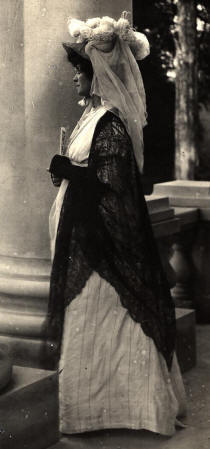
Kate Matthews forever captured Amanthis Bullitt Smith Jungbluth’s haunting image
in this picture taken on Waldeck’s columned front porch
Unhappy with life at Waldeck — it was too far removed from the excitement of the city to suit her – Amanthis purportedly had an affair which led to the breakup of the Jungbluth marriage. After her divorce, she lived for a time with her brother, George Weissinger Smith, according to the 1910 census. We believe that in 1913, she became one of the first residents of Louisville’s Puritan Hotel, now the Puritan Apartments at 1244 S. Fourth Street.
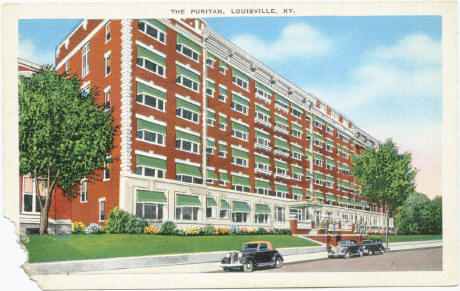
The Puritan
Devastated by his wife’s infidelity, Karl sold Waldeck and most of its contents to the Messendorfs for $3000 in 1908 and moved to St. Petersburg, Florida where he built another home, also named Waldeck, and married again.
At the time of the divorce, Karl, Jr. was already married (1903) to Amelia Cowling. They had two children: Mary Churchill Jungbluth (1904) and Amelia Churchill Jungbluth (1915). Karl, Jr. received his law degree from the University of Louisville and served as a Louisville alderman for ten years. His older daughter, Mary, married Roland Whitney in 1929 and had a daughter, Nina Churchill Whitney in 1930.
Marion married the daughter of the Arkansas governor and had no children. They lived in Colorado.
Mamie Lawton (“Mrs. Walton”) wrote about Amanthis’ affair in a 1906 letter to Annie Fellows Johnston:
…I told you everyone was there but Mrs. Jungbluth was conspicuous by her absence. Being at present on very official terms with the parson, whom she refuses to hear preach anymore. There are I believe, several “official” affairs, in Cranford just now. I don’t know anything accurate, but from the tom-tit of society, I gather a few stray bits of gossip – Aleck won’t play cards with the Buckners – Lese won’t meet Aleck – Amanthis refuses to be friends with the new parson…
Did Mrs. Jungbluth’s marital indiscretions inspire Annie Fellows Johnston to pen the Little Colonel’s disillusioned dissertation on marriage, below, in her 1907 novel, “The Little Colonel’s Knight Comes Riding”, Chapter13.htm?
“That’s the worst thing about growing up,” she exclaimed bitterly when Mrs. Bisbee paused, “the finding out that everybody isn’t good and happy as I used to think they were. Lately, just these last few months that I’ve been out in society I’ve heard so much of people’s jealousies and rivalries and meannesses and insincerity, that I’d sometimes be tempted to doubt everybody, if it were not for my own family and some of the people out in this little old Valley that I’ve trusted all my life.
“There’s Minnie Wayland, whose engagement was announced last month to Mistah Maybrick. I don’t see how she dares marry when her own fathah and mothah made such a failure of it, that they can’t live togethah, and Mistah Maybrick’s wife got a divorce from him on account of some dreadful scandal the papahs were full of. I couldn’t go up and wish her joy when the othah girls did. She talked about it in such a flippant mattah of business way, as if millions atoned for everything. One of the girls laughed at me for taking it so seriously, and said that matches aren’t made in heaven nowadays, and that I’d have to get ovah my old-fashioned Puritanical notions and ideals if I expected to keep up with the sma’ht set. I thought for awhile that maybe it was only the sma’ht set who are that way, but what you’ve just told me about Mrs. Cadwell, and what I’ve heard lately about several families right in our own little neighbahhood, shows that it’s all a bad old world, and these yeahs I’ve been thinking it so good I’ve been blind and ignorant. I suppose it’s for the best, but I’m sorry sometimes that my eyes have been opened.”
Amanthis died on November 20, 1948 and was buried in Cave Hill Cemetery http://www.cavehillcemetery.com/, Section 14, Lot 252, grave 1, with her brother, Thomas Floyd Smith, III’s family. Her ex-husband Karl is buried in St. Petersburg, Florida.
Karl’s oldest son, Karl, Jr. (1876-May 14, 1944) is also buried in Cave Hill http://www.cavehillcemetery.com/, but in Section Q, lot 51, along with his wife, Amelia Cowling Jungbluth (1877-1954); his daughter, Mary Churchill Jungbluth Whitney (died 1997); his brother, Marion (1877-1940); his son-in-law, Roland Whitney (died 1973); and his mother, Mrs. Mamie Jungbluth (1854-1877).
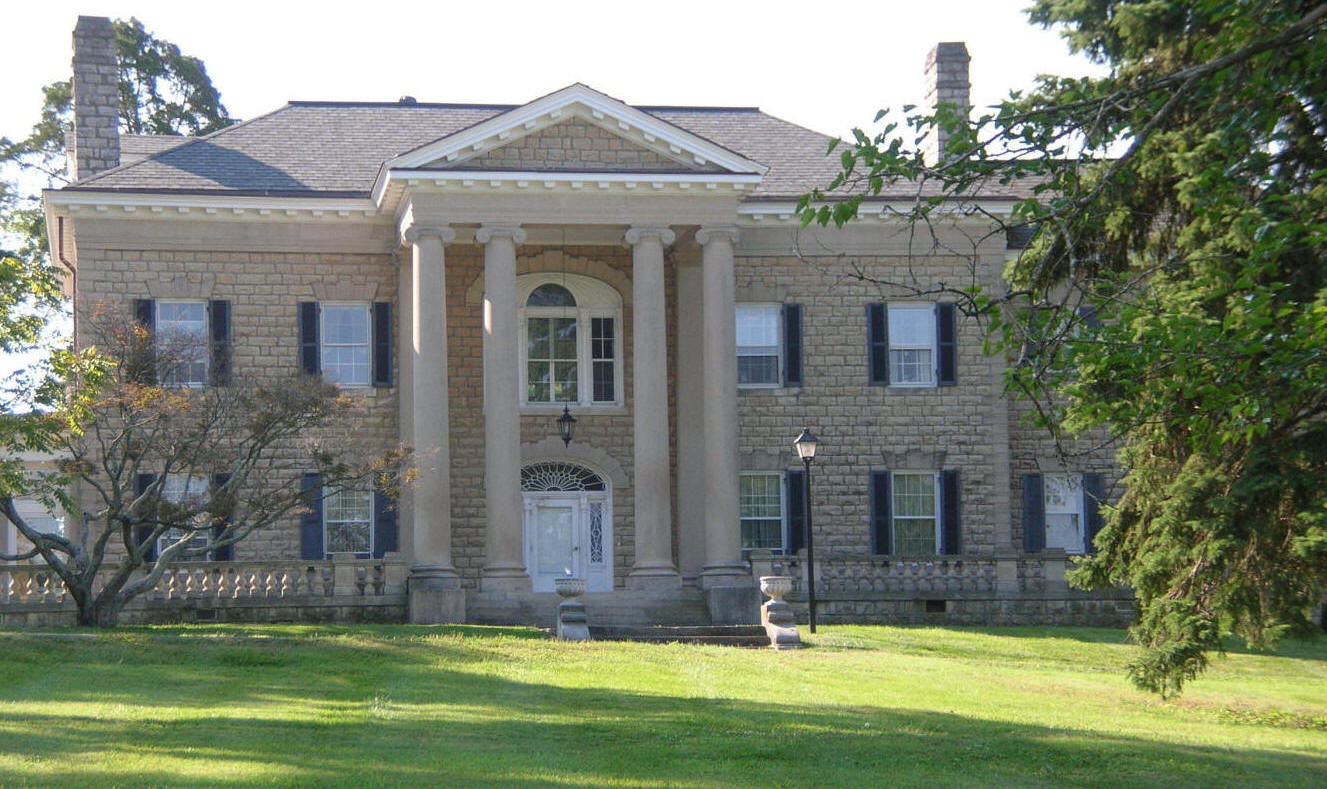
Waldeck, the Jungbluth home in Crestwood, as it appears today
Waldeck mansion still stands at 5900 W. Highway 22 in Crestwood and is part of a 1,500-acre farm. The mansion can
be rented for weddings and/or receptions as well as other special events
Click here to continue to page 2, Beechmore: The Jennie Casseday Rest Cottage Years
Thanks to Olivia Smith for providing information about Captain Thomas Floyd Smith’s portrait; to Toni Langlais for the census information about Beechmore; to Helena McCoy Grimes and her husband, David Gleason, current owners of Tanglewood and Waldeck, for providing historical background about Waldeck and the Jungbluth family; and to Alexandra Luken for census information about the Smith family and photos of their grave sites at Cave Hill Cemetery.
page by Donna Russell
**********************************
From Michael Chouteau Larned (email available on request to folks with a legitimate interest)
“I found that Emilie Antoinette Chouteau 1802-1843 was married to Thomas Floyd Smith, Major, 1784-1843. They had five children, Philomena (my ancestor), Thomas Floyd Jr., Louis Chouteau, Azzelda and Mary. Thomas Floyd Smith Jr. 1832-1888 married Blanche Weissinger. The inscription on Emilie’s stone is very indistinct in the online photos…the dates would be helpful to know.”
Emilie Chouteau Smith is buried at Cave Hill in Louisville in the The Old Colonel’s family plot along with two other unidentified burials. More in the links above.
Blanche Weissinger was the Old Colonel’s sister, daughter of Amanthis Bullitt. Small world that was.
For more of the family relations see http://www.kygenweb.net/history/ff_louisville/c2.htmpp28-29ff.
